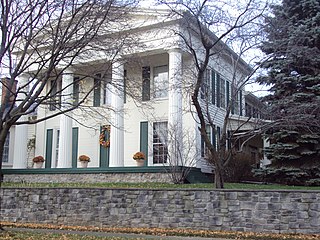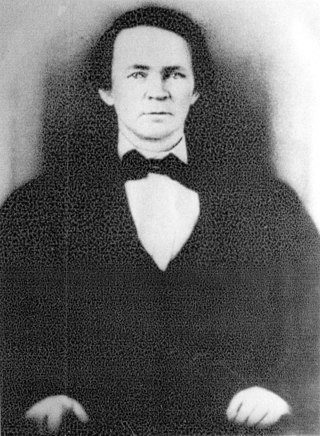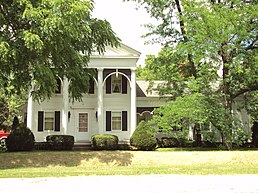
The Noble–Seymour–Crippen House is a mansion located at 5624 North Newark Avenue in Chicago's Norwood Park community area. Its southern wing, built in 1833, is widely considered the oldest existing building in Chicago. As well as the 22nd oldest in the state of Illinois.

Madison Historic District in Madison, Georgia is a historic district that was listed in the National Register of Historic Places in 1974. Its boundaries were increased in 1990 and it then encompassed 356 contributing buildings, three other contributing structures, four contributing objects, and three contributing sites.

The Henry W. Baker House is located at 233 S. Main St. in Plymouth, Michigan. It was built by its original owner as a private home, but now houses commercial space. It was designated a Michigan State Historic Site in 1981 and listed on the National Register of Historic Places in 1982.

The Rudolph Nims House is a private residence located at 206 West Noble Street in the city of Monroe in Monroe County, Michigan. It was listed as a Michigan Historic Site on October 29, 1971 and added to the National Register of Historic Places on October 18, 1972.

The Ephraim and Emma Woodworth Truesdell House is a private house located at 1224 Haggerty Road in Canton Township, Michigan. The structure is significant because it is one of the most finely crafted houses in the township and because of its association with one of the most important families in the area. It was listed on the National Register of Historic Places in 2003.

The Thomas and Maria Blackman Bartlett House was built as a private house at the corner of Canton Center and Warren Roads. It was donated to Canton Township and relocated to its current site at 500 N. Ridge Road in Cherry Hill, Michigan. It was listed on the National Register of Historic Places in 2000.

The Samuel W. Temple House is a residential structure located at 115 West Shawnee Street, at the junction with North Pearl Street, in the city of Tecumseh in Lenawee County, Michigan in the United States. It was designated as a Michigan Historic Site and added to the National Register of Historic Places on August 13, 1986.

Susina Plantation is an antebellum Greek Revival house and several dependencies on 140 acres near Beachton, Georgia, approximately 15 miles (24 km) southwest of the city of Thomasville, Georgia. It was originally called Cedar Grove. The house is listed on the National Register of Historic Places, and is currently a private residence.

John Wind was an architect who designed his work in southwest Georgia in the United States from approximately 1838 until his death in 1863. He was born in Bristol, England, in 1819. John Wind designed the Greenwood, Susina, Oak Lawn, Pebble Hill, Eudora and Fair Oaks monumental plantation houses, the Thomas county courthouse and a few in-town cottages. William Warren Rogers writes "Some of Wind's work still exists and reveals him as one of the South's most talented but, unfortunately, least known architects." John Wind also worked as an inventor, jeweler, master mechanic and surveyor. He devised a clock that remained wound for one year and was awarded a patent for a cotton thresher and cleaner, Patent Number 5369. He was also the co-recipient of a corn husker and sheller patent in 1860. But it was his work and creations as an architect that made him an enduring figure that left a mark on society.

The General Squier Memorial Park is a park located at 4725 South Mill Road in Dryden Township in southeastern Lapeer County, Michigan. It was designated as a Michigan Historic Site on June 6, 1977 and later added to the National Register of Historic Places on June 5, 1986, as the Dryden Community Country Club–General Squier Historic Park Complex. The site is also known locally as the General George Squier Club or General Squier County Park.

The Hannah Maria Libby Smith House, also known as the Arnel Milner Home, is a historic house located in Provo, Utah, United States. It is listed on the National Register of Historic Places.

The Lambrite–Iles–Petersen House is a historic home located in the Hamburg Historic District in Davenport, Iowa, United States. The district was added to the National Register of Historic Places in 1983. The house was individually listed on the Davenport Register of Historic Properties in 2012. This was the first residence built in the city in the Italian villa style and one of the earliest examples in the state of Iowa. The house is named for three of its early owners: Joseph Lambrite, a lumber mill owner who built the house, Dr. Thomas Iles, a physician, and John H.C. Petersen, who founded Davenport's largest department store that grew to become Von Maur.

Gordon Hall, also known as the Judge Samuel W. Dexter House, is a private house located at 8341 Island Lake Road in Dexter, Michigan. It was designated a Michigan State Historic Site in 1958 and listed on the National Register of Historic Places in 1972. The house is unique in Michigan for its balance, large scale, and massive hexastyle portico. The structure is also significant as the dwelling of Judge Samuel W. Dexter, a pioneering Michigan resident and land baron who had a substantial impact on early development of Washtenaw County and other sections of the state. The house was later owned by Dexter's granddaughter Katharine Dexter McCormick, a pioneering research scientist, suffragist, and philanthropist. In its early days, Gordon Hall hosted at least two, and possibly three United States presidents, and it was almost certainly a stop along the Underground Railroad.

The Fountain–Bessac House, also known as the Fountain-Haeussler House, is a private house located at 102 W. Main Street in Manchester, Michigan. It was designated a Michigan State Historic Site in 1986 and listed on the National Register of Historic Places in 1988.
The Sibley-Hoyt House is a historic house in Pontiac, Michigan that's center is a frame cabin dating to 1820 making it one of Pontiac's first structures. It was built by Solomon and Sarah Sibley, one of the founders of Pontiac. It is also the county's oldest house.

The Ward-Holland House is a private house located at 433 North Main Street in Marine City, Michigan. It was listed on the National Register of Historic Places in 1972.

The Erastus Bolles House is a historic house in Afton, Minnesota, United States. It was built in 1856 in what was then the separate community of Valley Creek. The house was listed on the National Register of Historic Places in 1982 for its local significance in the themes of architecture and exploration/settlement. As one of the original houses in Valley Creek, it was nominated for helping to depict one of the many small Washington County settlements that formed around a commercial venture—though one that never progressed to formal platting—and the community's two-decade preference for Greek Revival architecture. Valley Creek was later formally incorporated into Afton.

The William H. and Sabrina Watson House is a single-family home located at 507 Cedar Street in Lapeer, Michigan. It was listed on the National Register of Historic Places in 1985.

The Franklin Boulevard Historic District is a primarily residential historic district located in Pontiac, Michigan along Franklin Boulevard between West Huron Street and Orchard Lake Avenue. It also contains structures along Mary Day and Henry Clay Avenues between Franklin and Miller, and some structure along West Huron between Franklin and Williams, and along West Lawrence between Williams and the railroad. The district was listed on the National Register of Historic Places in 1983.

The Bell-Spalding House, also known as the Tuomy House, is a single-family home located at 2117 Washtenaw Avenue in Ann Arbor, Michigan. It was listed on the National Register of Historic Places in 1990.























